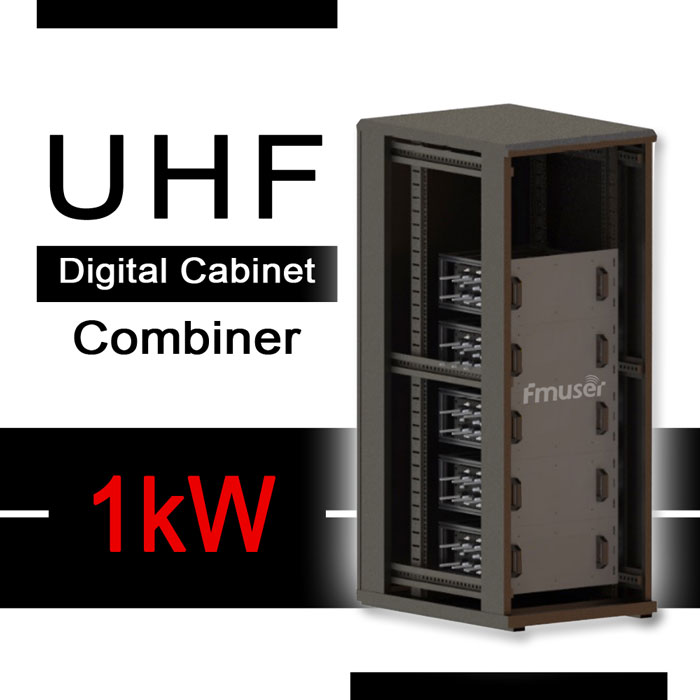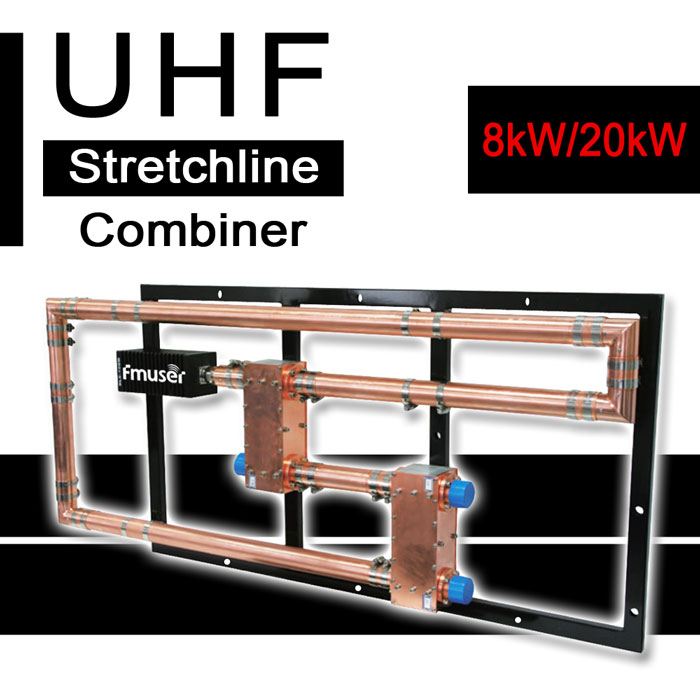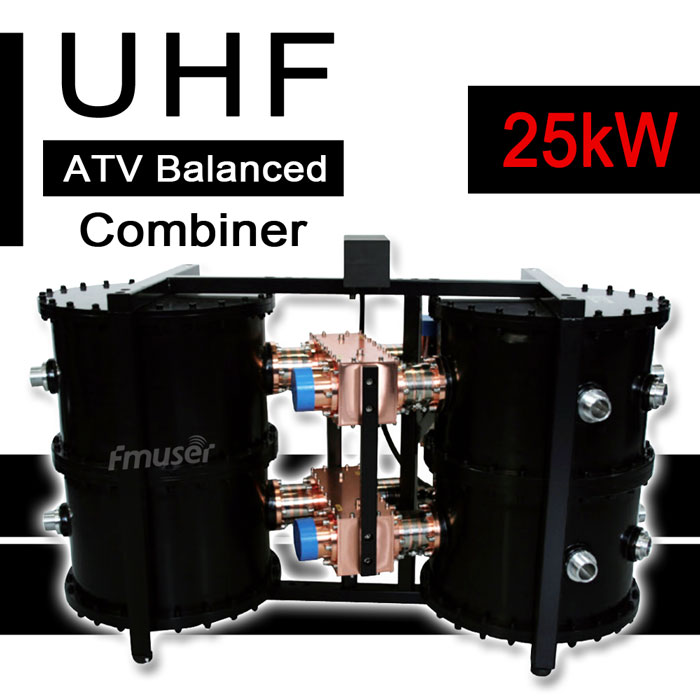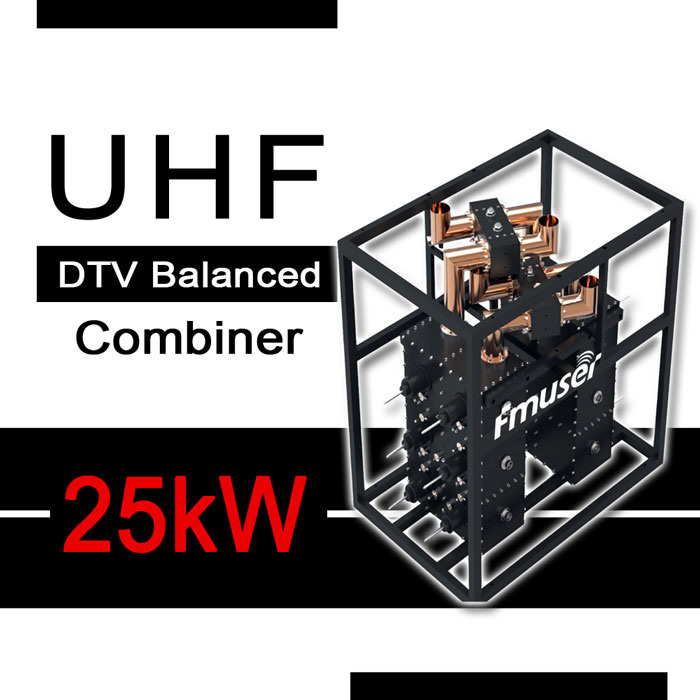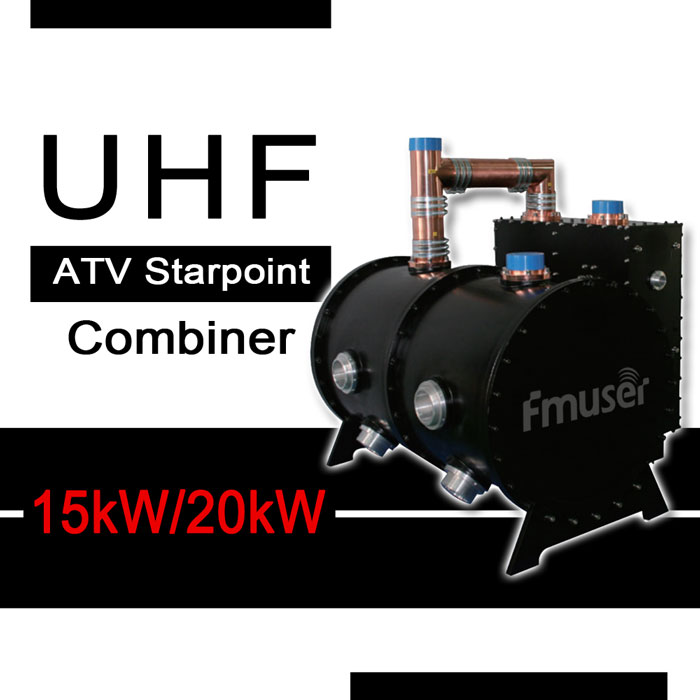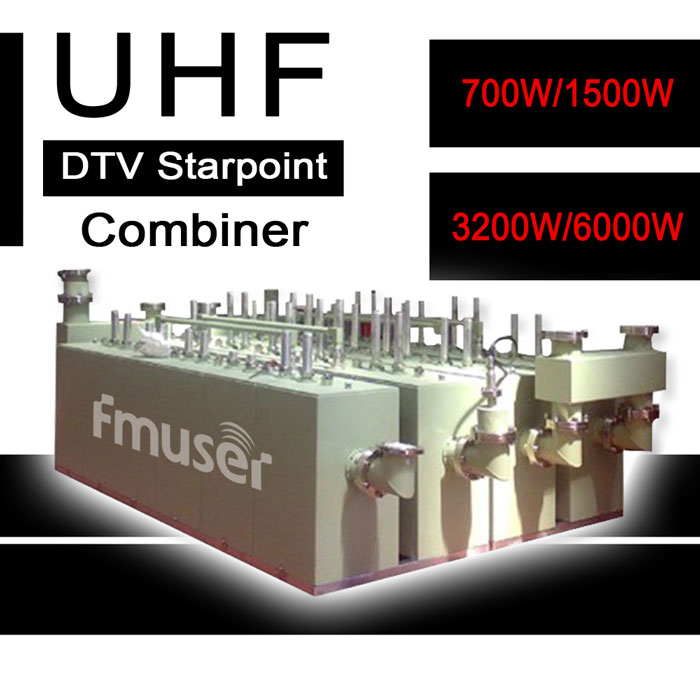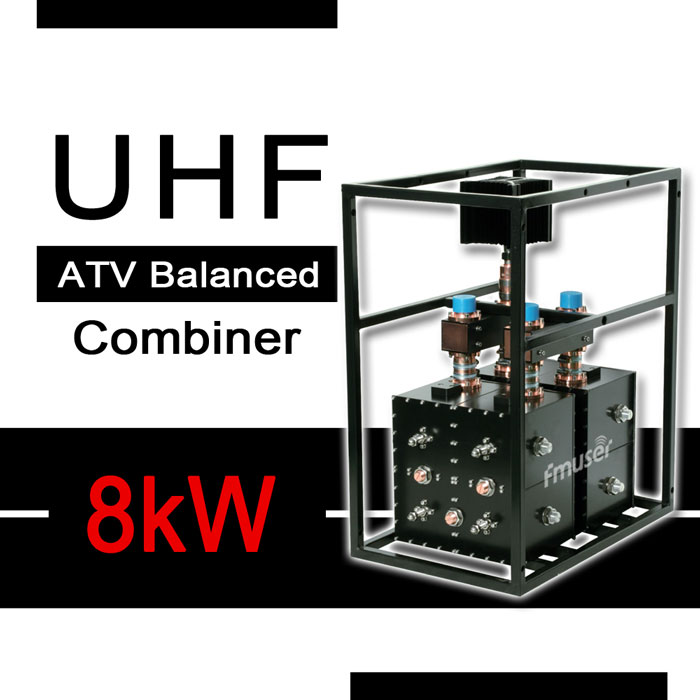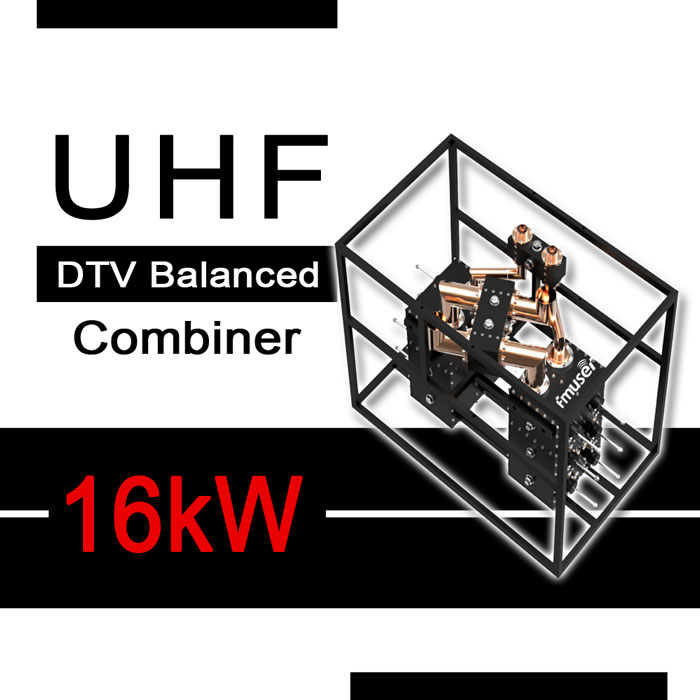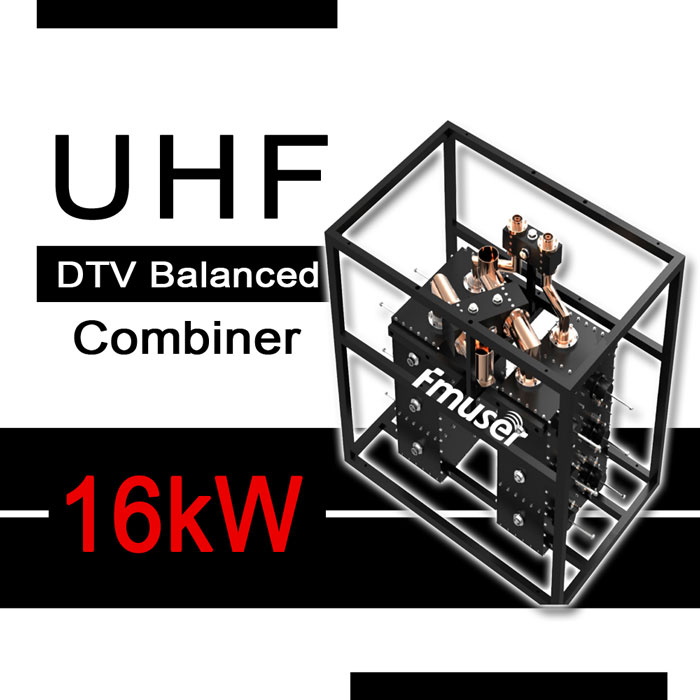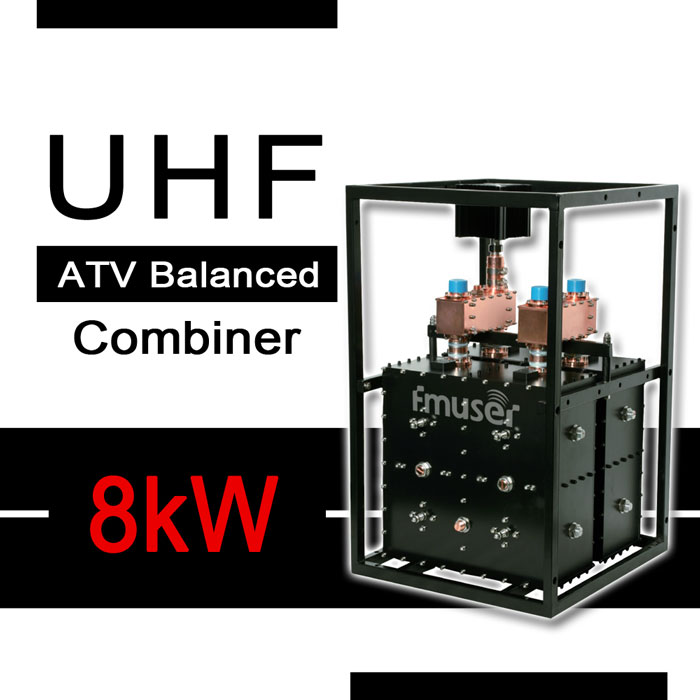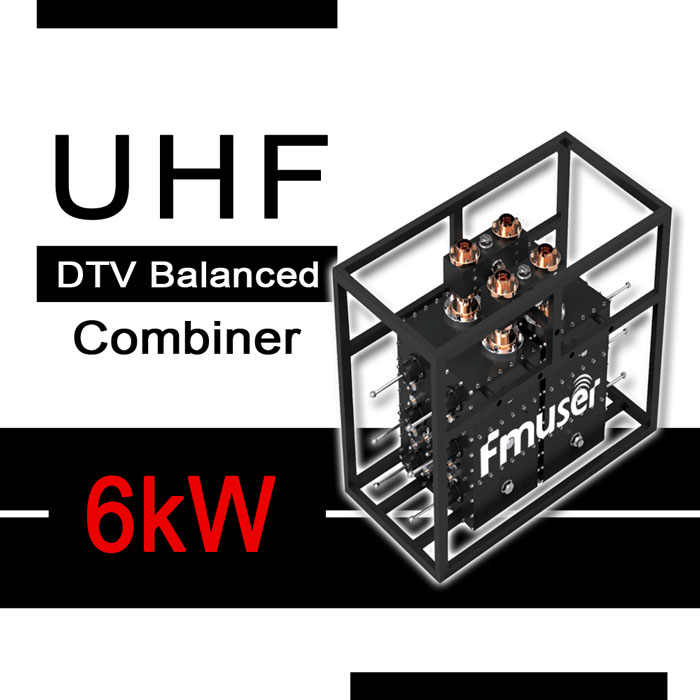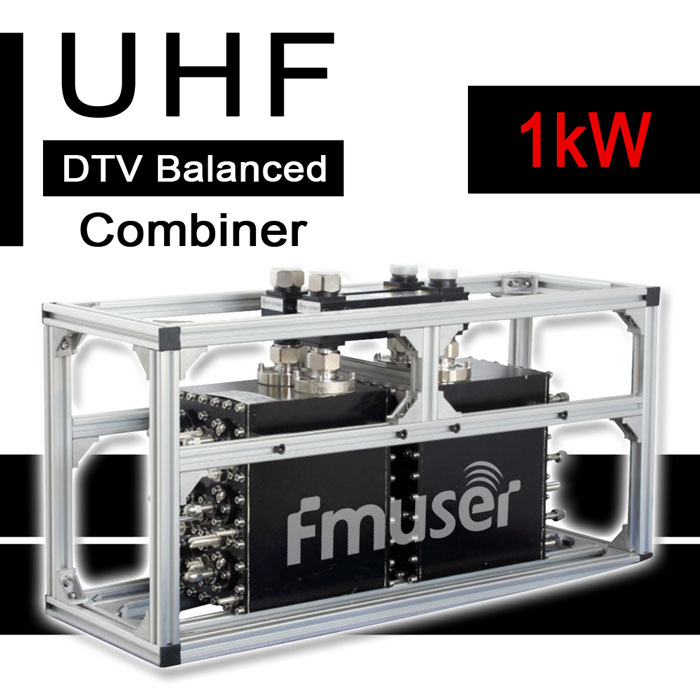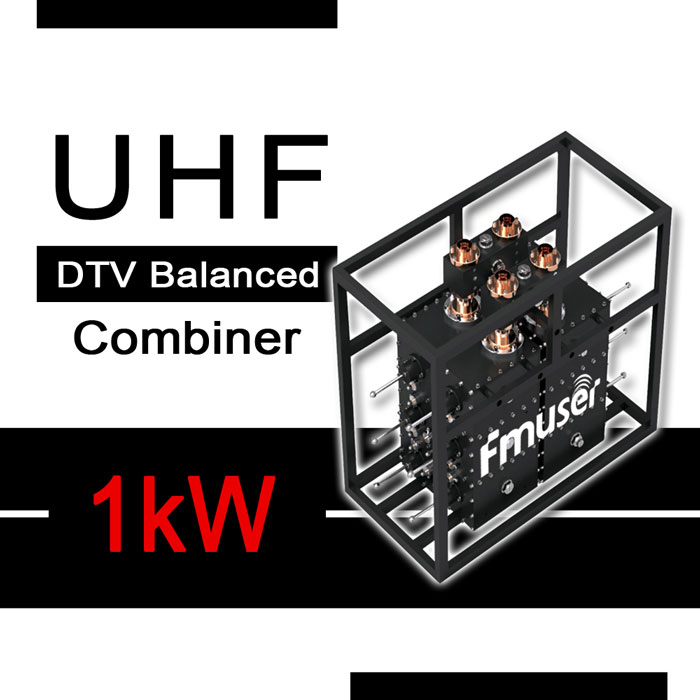
UHF Combiners
UHF Cavity Combiners are critical RF solutions used for combining multiple signals in the ultra-high frequency (UHF) spectrum into one or two output signals in telecommunications, broadcasting, and industrial networks. Additionally, UHF combiners can be used for combining multiple transmitters into one antenna for broadcasting, combining multiple receivers into one antenna for receiving signals, and combining multiple wireless networks into one antenna. At FMUSER, we specialize in advanced RF systems engineering, providing precision combiners that simplify complex signal management.
1. Engineered for Excellence: Introduction & Overview
This page categorizes our UHF Cavity Combiners by frequency range (400-960 MHz), power capacity (1kW to 50kW), and application (broadcast, public safety), empowering system integrators to quickly identify solutions for projects like DTV towers or emergency communication networks.
2. Peak Performance: Key Features of FMUSER’s UHF Cavity Combiners
- Proven Durability: Robust aluminum alloy construction with IP65-rated enclosures for harsh environments.
- Certified Efficiency: CE/FCC compliance and <0.2dB insertion loss to maximize signal integrity.
- Scalable Solutions: Entry-level 4-port models to 16-port industrial systems for growing networks.
- Smart Flexibility: Frequency-agile designs and modular configurations for future upgrades.
3. Powering Industries: Diverse Applications
- Broadcast Television & Radio: FMUSER combiners merge multiple transmitters into a single antenna, reducing tower space and interference for HD broadcasts.
- Military & Aerospace Communication: High-power, EMI-shielded combiners ensure mission-critical signal reliability in radar and SATCOM systems.
- Public Safety Networks: Fail-safe redundancy and rapid deployment kits keep emergency responder networks operational 24/7.
- Stadium/Concert RF Systems: Low-noise combiners support multi-channel wireless mics and live broadcast feeds without cross-talk.
4. Why FMUSER? Turnkey Solutions Engineered for Success
- Factory-Direct Savings: 30% lower costs with in-house R&D and bulk production.
- Always Ready: 500+ combiners in stock, shipping globally in 3 days.
- Tailored Support: Free pre-configuration, on-site installation (optional), and OEM customization.
- Proven Expertise: Trusted by BBC, Ericsson, and national broadcasters across 50+ countries.
5. Smart Selection: Buying Guide
- Frequency Range: Match to local UHF spectrum (e.g., 470–862MHz for EU DVB-T).
- Power Handling: Align with transmitter output (10kW+ for large TV towers).
- Budget Flexibility: Entry models from $1,200 to full redundancy systems at $15,000+.
-
![470-862 MHz 7/16 DIN 1kW Solid State UHF Transmitter Combiner Starpoint Compact 1000W 6 Cavity Duplexer for TV Broadcasting]()
Price(USD):Ask for a quotation
Sold:11
-
![470-862 MHz 8kW/20kW Stretchline UHF Transmitter Combiner Tunable RF Channel Combiner with 1 5/8" 3 1/8" Input for TV Station]()
Price(USD):Ask for a quotation
Sold:9
-
![470-862 MHz 3 1/8" 6 Cavity 25kW Balanced CIB UHF Transmitter Combiner ATV TV TX RX Duplexer Compact UHF Combiner for TV Station]()
Price(USD):Ask for a quotation
Sold:7
-
![470-862MHz 25kW 4 1/2" Input Compact UHF RF Combiner High Power UHF 6 Cavity Duplexer Solid State DTV TX Combiner for TV Station]()
Price(USD):Ask for a quotation
Sold:7
-
![470-862 MHz 15kW 20kW 3 1/8" Starpoint UHF Transmitter Combiner Analog TX RX Combiner Compact 4 Cavity Duplexer for TV Station]()
Price(USD):Ask for a quotation
Sold:7
-
![470-862 MHz Starpoint UHF Transmitter Combiner 6 Cavity Duplexer 7/16 DIN 1 5/8" 3 1/8" Supported 700W to 6kW Customized Power]()
Price(USD):Ask for a quotation
Sold:4
-
![470-862 MHz 8kW UHF 4 Cavity Duplexer 1 5/8" Compact TX Combiner Channel Plus High Power UHF Transmitter Combiner for TV Station]()
Price(USD):Ask for a quotation
Sold:2
-
![470-862 MHz 16kW 1 5/8" 3 1/8" Balanced CIB 6 Cavity Duplexer Compact DTV UHF Transmitter Combiner TX RX Duplexer for TV Station]()
Price(USD):Ask for a quotation
Sold:2
-
![470-862MHz 1 5/8" 3 1/8" 6 Cavity 16kW Balanced Radio Combiner 2 Way RF Combiner Compact Radio Frequency Combiner for TV Station]()
Price(USD):Ask for a quotation
Sold:9
-
![470-862 MHz 1 5/8" 4 Cavity 8kW Balanced Duplexer Compact ATV UHF Transmitter Combiner Solid state Duplexer for TV Broadcast]()
Price(USD):Ask for a quotation
Sold:7
-
![470-862 MHz 1 5/8" 6kW Compact UHF Cavity Duplexer 4 Way RF Combiner High Power DTV UHF transmitter Combiner for TV Broadcasting]()
Price(USD):Ask for a quotation
Sold:9
-
![470-862 MHz 7/16 DIN 1kW UHF TV Combiner Compact Balanced RF Signal Combiner Solid State DTV UHF Cavity Duplexer for TV Station]()
Price(USD):Ask for a quotation
Sold:4
-
![470-862 MHz 1 5/8" 6 Cavity Solid State 1kW DTV UHF Transmitter Combiner Compact Radio Repeater Duplexer Filter for TV Broadcast]()
Price(USD):Ask for a quotation
Sold:6
- How do you use an UHF combiner for broadcasting?
- Steps to correctly install an UHF combiner in a broadcast station:
1. Install the combiner in a dry, dust-free environment.
2. Connect all of the UHF antenna inputs to the combiner in the correct order.
3. Connect the output of the combiner to the transmitter.
4. Make sure to properly ground the combiner.
5. Verify that all components are properly connected and functioning.
Common problems to avoid when using an UHF combiner in a broadcast station:
1. Connecting the wrong type of antenna to the combiner.
2. Not connecting the combiner to the proper ground.
3. Not properly tuning the combiner.
4. Not properly setting the power levels of the connected transmitters.
5. Not setting the correct frequency to the combiner.
- How does an UHF combiner work?
- An UHF combiner is a device used in broadcast stations to combine multiple UHF signals into a single output. It works by combining the signals from multiple transmitters and amplifying them into a single output. This allows broadcasters to ensure that the signal from multiple transmitters is combined into one strong signal that can be received by a receiver.
- Why is an UHF combiner important for a radio station?
- A UHF combiner is important for broadcast stations because it combines multiple UHF signals into one output, allowing broadcasters to create a more efficient transmission of their signal. This allows broadcasters to reach a larger audience, reducing the amount of power needed and equipment needed to transmit their signal. It is necessary for a broadcast station if they want to reach a larger audience.
- How many types of VHF combiners are there and what are the differences between them?
- There are two main types of UHF combiners: passive and active. Passive UHF combiners are simple, low-cost devices that combine multiple signals into one signal with minimal signal loss. Active UHF combiners are more complex devices that incorporate amplifiers and filters to improve signal gain and reduce noise. The main difference between the two is that active UHF combiners are more expensive and provide better signal quality, whereas passive UHF combiners are simpler, less expensive, and provide poorer signal quality.
- How do you choose the best VHF combiner?
- When choosing the best UHF combiner for a broadcast station, it is important to consider the number of inputs and outputs, the gain, the noise figure, the isolation, the return loss, and the power handling. Additionally, you should make sure you review the construction quality, the warranty, and the company’s customer support. Finally, you should compare prices and features across multiple brands to ensure you get the best value for your money.
- How do you correctly connect an UHF combiner into the broadcast system?
- 1. Connect the output of the exciter to the input of the UHF combiner.
2. Connect the output of the UHF combiner to the input of the amplifier.
3. Connect the output of the amplifier to the input of the antenna.
4. Ensure that all cables are secured and have proper grounding.
5. Adjust the gain of the amplifier as needed.
6. Test the UHF combiner with a signal generator to ensure proper operation.
- What equipment is related to an UHF combiner?
- The equipment related to an UHF combiner in a broadcast station include antenna arrays, antenna couplers, RF amplifiers, RF filters, RF switches, RF attenuators, and power supplies.
- What are the most important physical and RF specifications of an UHF combiner?
- The most important physical and RF specifications of an UHF combiner include:
Physical Specifications:
• Size: The size of the combiner is important when considering whether it will fit into the available space.
• Weight: The weight of the combiner should be considered when considering whether it can be easily transported and installed.
• Enclosure: The enclosure of the combiner should be robust enough to protect the internal components from environmental conditions.
RF Specifications:
• Frequency Range: The frequency range of the combiner should cover the desired UHF frequency range, typically between 470-698 MHz.
• Isolation: The isolation of the combiner should be high enough to ensure that the signals from each port do not interfere with each other.
• Insertion Loss: The insertion loss of the combiner should be low enough so that the signal power is not significantly reduced as it passes through the combiner.
• Return Loss: The return loss of the combiner should be high enough to ensure that the signal is reflected back with minimal distortion.
- How do you correctly maintain an UHF combiner as an engineer?
- 1. Inspect the combiner for any signs of physical damage or deterioration.
2. Clean the internal components of the combiner with a dry cloth and/or compressed air to remove dust and debris.
3. Check the RF input and output levels using an RF watt meter.
4. Inspect all cables and connectors for any loose or faulty connections.
5. Check the power supply and voltage levels to ensure they are within normal operating parameters.
6. Check the settings and adjustment of the combiner's filters and passband to ensure they are correct.
7. Perform any necessary repairs or replacements.
8. Document all maintenance activities.
- How do you repair an UHF combiner if it is not working?
- To repair a UHF combiner, you will need to first identify the problem. If the combiner is not working, you will need to check all of its components for any signs of damage or deterioration. Once the problem has been identified, you can then replace any broken or malfunctioning parts. Depending on the type of UHF combiner, you may need to use specialized tools and parts to make the repair. Once the parts have been replaced, you should be able to fully test the combiner and ensure it is working correctly.
- How do you choose the right packaging for an UHF combiner?
- When choosing the right packaging for an UHF combiner, it is important to make sure the packaging is designed to provide adequate protection from dust, moisture, and other environmental elements. Additionally, the packaging should be strong enough to protect the combiner from physical damage during shipping and handling. When transporting the combiner, extra care should be taken to ensure that it is properly secured, as movement or vibration during transportation can damage the combiner.
- What material is used for the casing of an UHF combiner?
- The casing of a UHF combiner is generally made of metal, such as aluminum or steel, and these materials will not affect the performance of the device.
- What is the basic structure of an UHF combiner?
- The basic structure of an UHF combiner consists of an input network, a mixing network, an output network and a filter. The input network is responsible for directing the input signals to the combiner, while the mixing network is responsible for combining the signals. The output network is responsible for taking the combined signal and directing it to the desired output. Finally, the filter is responsible for blocking undesired signals and harmonics. Each of these structures plays an important role in determining the performance and attributes of the combiner. Without any of these structures, the combiner would not be able to work normally.
- Who should be assigned to operate an UHF combiner?
- The person assigned to manage an UHF combiner in a broadcast station should possess technical expertise, troubleshooting skills, and the ability to work independently.
- How are you?
- I am fine
CONTACT US


FMUSER INTERNATIONAL GROUP LIMITED.
We are always providing our customers with reliable products and considerate services.
If you would like to keep touch with us directly, please go to contact us
